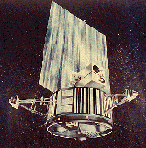|
|
The OSO-8 Satellite
 The 8th Orbiting Solar Observatory (OSO-8) was
launched on 21 June 1975. While OSO-8's primary objective was to observe
the Sun, four instruments were dedicated to observations of other
celestial X-ray sources brighter than a few milliCrab.
OSO-8 ceased operations on 1 October 1978.
The 8th Orbiting Solar Observatory (OSO-8) was
launched on 21 June 1975. While OSO-8's primary objective was to observe
the Sun, four instruments were dedicated to observations of other
celestial X-ray sources brighter than a few milliCrab.
OSO-8 ceased operations on 1 October 1978.
Mission Characteristics
 Lifetime : 21
June 1975 - 1 October 1978 Lifetime : 21
June 1975 - 1 October 1978
 Energy Range :
0.15 keV - 1 MeV Energy Range :
0.15 keV - 1 MeV
 Payload : Payload :
- GSFC Cosmic X-Ray Spectroscopy Experiment (GCXSE)
Detector A (2-60 keV): Eff. area = 263 cm2, FOV = 5°
Detector B (2-20 keV): Eff. area = 37 cm2, FOV = 3°
Detector C (2-60 keV): Eff. area = 237 cm2, FOV = 5°
- High Energy Celestial X-ray Experiment
0.01-1 MeV eff. area 27.5 cm2, FOV 5°
- Soft X-ray Background Radiation Experiment
0.15-45 keV eff. area 51.8 cm2, 43.0 cm2, 41.7
cm2, FOV 2.7° with 3° spatial resolution
- Graphite Crystal X-ray Spectrometer
2-8 keV, FOV 3°
 Science Highlights:
Science Highlights:
- Iron-line detection in the X-ray spectra of a cluster of galaxies.
- Detection of Black-Body spectrum from X-ray bursts.
- Set upper limit on the polarization of radiation from several X-ray
binaries.
 Archive : Lightcurves and Raw data from the GCXSE.
Archive : Lightcurves and Raw data from the GCXSE.
[OSO-8 Home]
[About OSO-8]
[Archive]
[Software]
[Gallery]
[Publications]
Page authors: Lorella Angelini Jesse Allen
HEASARC Home |
Observatories |
Archive |
Calibration |
Software |
Tools |
Students/Teachers/Public
Last modified: Tuesday, 21-Apr-2020 15:39:42 EDT
|
 The 8th Orbiting Solar Observatory (OSO-8) was
launched on 21 June 1975. While OSO-8's primary objective was to observe
the Sun, four instruments were dedicated to observations of other
celestial X-ray sources brighter than a few milliCrab.
OSO-8 ceased operations on 1 October 1978.
The 8th Orbiting Solar Observatory (OSO-8) was
launched on 21 June 1975. While OSO-8's primary objective was to observe
the Sun, four instruments were dedicated to observations of other
celestial X-ray sources brighter than a few milliCrab.
OSO-8 ceased operations on 1 October 1978.

